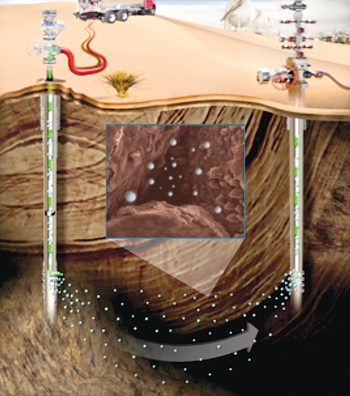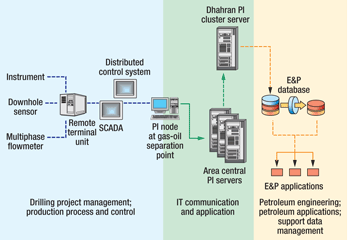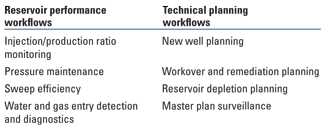Leveraging real-time data has increased production rates and improved reservoir management and production operations.
Tofig A. Al-Dhubaib and Heather F. Bence, Saudi Aramco
Recent advancements in well technologies, communications and field instrumentation have made it possible to achieve total asset awareness and optimize operations over a field’s development lifecycle. By leveraging and integrating real-time data from surface and subsurface technologies, continuous monitoring and right-time response are achieved throughout the development processes of Saudi Aramco’s hydrocarbon fields. This integration has led to optimized drilling operations and well placements, increased production rates, and improved reservoir management and production operations.
Saudi Aramco has capitalized on digital surface and subsurface well technologies to optimize fields’ development and operation strategies. This is being done through four major projects: real-time drilling, real-time geosteering, intelligent fields and event solution field development optimization.1 One of the major objectives of these projects is to integrate and leverage multidisciplinary team collaboration and real-time field data through all the phases of a field’s development and management lifecycle—from drilling and geosteering, intelligent completions, production and reservoir management all the way to initiating development plans and building and updating the static, dynamic and business models. The overall objective is to optimize intra- and interbusiness processes, since these phases are interdependent, and the knowledge and process improvement gained at any one phase significantly influences the overall process. This, in turn, provides an opportunity to further enhance practices and strategies in the entire field development and management cycles.
This article focuses on the development and implementation of Saudi Aramco’s “intelligent fields” capabilities, which are among the company’s key strategic imperatives aimed at optimizing field development and operation strategies. The intelligent-fields program’s objectives include enhancing hydrocarbon recovery through in-time intervention and full-field optimization; enhancing HSE through remote monitoring and intervention; and reducing operating costs by minimizing manual supervision and intervention.
To achieve these objectives, the intelligent-fields program is being implemented on two parallel paths. One involves installing fit-for-purpose instrumentation, sensors and actuators in new and old fields. The objectives of this path are to evaluate and exploit available intelligent-field technologies to address reservoir management and production objectives and to further the development of field instrumentation and data acquisition technologies. The second path is a structured development approach that captures the challenges and lessons learned and integrates required systems, specifications, processes and procedures for an overall solution that lays out an architecture for large-scale implementation and a company-wide rollout.
The intelligent-fields effort integrates processes, systems and organizations to achieve real-time and/or semi-automated field management. The systems to be integrated are diverse and span various technologies including measurement, data acquisition, control, communication, data management and applications, visualization systems and collaboration environments. These systems are managed and supported by different organizations within Saudi Aramco, each with its own business skill sets, mandate, processes and priorities. High-level management championship and close coordination with the various involved entities were essential in the successful development and implementation of such capabilities.
TECHNOLOGY DEVELOPMENT
To increase real-time data acquisition and operational capabilities throughout the reservoir, Saudi Aramco pursues research and development of cutting-edge technologies that provide additional capabilities for more complete reservoir surveillance and management. Novel technologies are increasing real-time actual readings and deep sensing between wells for better real-time reservoir management. In addition, developments in communications, network platforms and visualization are leading to more seamless and stronger intelligent-field systems.
Over the years, the intelligent field has developed the ability to monitor pressure, temperature and other parameters, such as oil, water and gas production, and to operate and monitor electrical submersible pumps and downhole and surface control valves. Near-wellbore technologies, such as the typical electric, acoustic and nuclear magnetic resonance logs, are widely used; however, with all the monitoring available, only data at discrete points at or near wells within the reservoir are measurable. In the interwell spacing, data has been inferred through various means from straight interpolation to reservoir simulation. To reduce the uncertainty inherent in reservoir surveillance, Saudi Aramco’s Exploration and Petroleum Engineering Center Advanced Research Center (EXPEC ARC) has embarked upon a long-term R&D program that moves from near-wellbore measurements toward measurements that are further from the wells and are deeper sensing. This includes electromagnetic (EM) technologies, borehole gravity meters, reservoir nano-agents and giga-cell simulation.
Electromagnetic technologies map resistivity and, in turn, fluid saturation. Two approaches have been making solid milestones: surface-to-borehole EM and crosswell EM. With surface-to-borehole EM, an EM source is placed in the borehole and receivers at the surface. This approach provides an areal picture of fluid migration and movement over time by conducting repetitive EM surveys and measuring their responses. Crosswell EM provides a cross-sectional resistivity image between two wells to provide fluid distribution mapping at interwell scale. Such advancements are beneficial in monitoring macroscopic sweep efficiency, planning infill drilling and improving reservoir simulation.
Borehole gravity meters measure density at a significant distance from a well through the casing. This leads to numerous applications throughout the lifecycle of a field, including time-lapse oil production monitoring. Collaborative research is underway to overcome limitations, such as size, stability and reliability of the hardware.
Reservoir nano-robots (Saudi Aramco’s proprietary Resbots)
will be sent through the reservoir to gather in situ data for enhanced reservoir mapping and characterization, Fig. 1. Resbots will sense the environment (pressure, pH, salinity, saturation, etc.) during their journey through the underground. A reactive version will be able to rectify unfavorable conditions, for example, by target-delivering chemicals where most needed. In the future, some Resbots may communicate data to the surface for real-time reservoir management. EXPEC ARC has conducted the first industry field experiment demonstrating the survivability of nanoagents in harsh reservoir conditions and their suitability as carriers for in situ sensing.
 |
|
Fig. 1. Resbots traveling through the reservoir from injector to producer. Insert: SEM photo with illustrated Resbots moving through rock pore.
|
|
GigaPOWERS, Saudi Aramco’s giga-cell reservoir simulator, already provides full-field billion-cell models at seismic scale with minimal upscaling. As a next step, it will be converted to a live interactive simulation model that predicts and optimizes reservoir performance.2,3 Since modern reservoir monitoring provides continuous online measurements of well pressures, temperatures, flowrates and, if available, additional measurements such as continuous seismic monitoring, the reservoir simulator is able to model these changes via petro-elastic modeling and can issue proactive voice or sound warnings and recommendations during live simulation to assist intelligent-field operations and reservoir monitoring.4 Such simulation-assisted intelligent field technologies can integrate and provide real-time information in an evolving cycle that “closes the loop” in the iterative process of improving reservoir models. Furthermore, new computational capabilities are being introduced in the reservoir simulator to increase performance by an order of magnitude or more to pursue the goal of true “interactive simulation” fast enough to accompany intelligent-field real-time operations for even the largest reservoirs. All these elements combined could lead eventually to autonomously operating fields.
DEVELOPMENT AND ARCHITECTURE
The intelligent-fields development architecture consists of four consecutive layers: surveillance, integration, optimization and innovation.5
The surveillance layer provides continuous upkeep and monitoring of all real-time data as collected by downhole, wellhead and surface sensors. This layer provides real-time data acquisition, communication, data management, basic visualization, event detection and alerts and is the foundation and key enabler for the intelligent field. The surveillance layer development is elaborate and complex, as most of its components require the integration of diverse systems: measurement, data acquisition, control, communication, data management and applications, visualization systems and collaboration environments. Due to the scale of Saudi Aramco’s operations, these systems are managed and supported by different organizations, Fig. 2.
 |
|
Fig. 2. Intelligent-fields data flow.
|
|
The integration layer continuously monitors reservoir behavior patterns, such as higher than expected watercuts or pressure declines. Reservoir regions or groups of wells are examined to study behaviors such as injection efficiencies and interwell pressure communication. In addition, pressure-transient behaviors are triggered and examined in real time. Inconsistencies between observed data and static reservoir models can be detected to trigger model updates. Systems will be provided to analyze reservoir behavior anomalies, examine causes and provide actionable information to the optimization layer.
The optimization layer provides a streamlined environment with full-system optimization covering the entire production system, including reservoir, well and surface facilities. A key component of this layer is an environment that allows for plug-and-play of all applications used within the optimization cycle. This cycle includes geology, integration of data to be used in simulation, upscaling, simulation, post-simulation and optimization recommendation analysis.
The innovation layer is where maximum advantage can be achieved, through efficient transformation of data to knowledge, capture of experiences, efficient workflow processes, timely intervention and optimization in strategic planning and field management practices. In this layer, collective expert thinking and dialogue are promoted to produce frontier solutions.
An assessment study resulted in the identification and prioritization of key reservoir management business processes for focused development in the integration, optimization and innovation layers. Initiatives launched through this effort include two intelligent field centers (IFCs) dedicated to real-time reservoir management as a pilot and nuclei for a growing contemporary practice in managing company assets; an integrated surface and subsurface model system; a reservoir management portal that integrates the reservoir management applications, tools and workflows and facilitates data loading; eight high-priority key reservoir management workflows6 for automation in the area of reservoir performance and technical planning (Table 1); software development of the eight workflows and their implementation in existing fields.7
| TABLE 1. Reservoir management workflows |
 |
COLLABORATION CENTERS
In addition to rapid advancements in surface and subsurface technologies, critical elements in achieving the corporate objective of expanding real-time reservoir management and production operations are the integration of multidisciplinary experts and enhanced reservoir management strategies and processes. Subsequently, there was a need for the development and implementation of a new business environment specifically designed to accommodate current and future reservoir management business processes and facilitate collaborative decision making around reservoir management processes and tasks. The IFC planning included collaboration, visualization, software, hardware, architectural, ergonomics and workflow aspects. As the intelligent-fields implementation unfolds, petroleum engineers will be dealing with more and more actionable overall field and reservoir data that require integration, visualization and collaboration between multidisciplinary teams for optimal assessment and decision making.
The IFCs are expert centers where multidisciplinary groups come together (physically and virtually) in a central facility—with the necessary data, applications and physical systems—to efficiently collaborate in order to address reservoir performance and technical planning matters or to resolve related issues. By doing so, the company is able to transform critical high-collaboration elements of reservoir management decision making and realize material improvements in reservoir and personnel productivity. The IFCs can also access the expertise of Saudi Aramco’s other real-time collaboration centers for comprehensive knowledge of the reservoir.
BENEFITS AND BUSINESS IMPACT
Saudi Aramco is achieving tangible and intangible benefits from the implementation of the intelligent-fields capabilities. Better understanding of reservoir pressure communication during the pre-injection stages is resulting in in-time optimum water injection management in new increments.7 Intelligent-fields processes helped to reduce planned AFK (Abu Hadriyah, Fadhili and Khursaniyah Fields) pre-injection requirements by 14% from the planned volume over three months by adjusting the injection rates in the three fields in 11 reservoirs.8
Other benefits have included the full evaluation of early inter-reservoir communication in a giant field in a matter of weeks rather than years (Arab-D and Hanifa communication in Khurais Field) and minimized well interventions for enhanced work efficiency and timely response to production deviations.9 Intelligent field capabilities in Haradh III resulted in a fourfold annual reduction in wireline jobs to collect static bottomhole pressure data. Other benefits are assurance in meeting the crude properties of a blend mixture from 11 AFK reservoirs’ crude grades at all times8; a balanced approach in generating data acquisition programs as the planned requirements and producing strategies are checked against each other in a quick and comprehensive fashion (field strategic surveillance master plan); and rapid training for young professionals through exposure to well performance, reservoir performance and facilities network behavior.
CONCLUSION
As Saudi Aramco moves its operations to more proactive field management and toward a future vision of self-governing and autonomous fields, the intelligent-fields processes and technologies will continue to expand as one of the strategic directions for its upstream businesses.
The next stage is to focus efforts on furthering the intelligent-fields utilization in production operations and to move toward creating interactions among three levels of interventions: fast interventions (e.g., open/close offending wells), strategic interventions (e.g., minimize watercut to increase recovery) and portfolio interventions (e.g., optimize reservoir rates to enhance fields’ production oil blends). These three levels of interventions require three levels of models, which are linked to create one synergized decision system that accommodates all decision levels without contradiction. This environment will trigger real-time actions to benefit both short-cycle and long-cycle/strategic intervention timeframes, and to ensure that both action sets remain in harmony. This system is the future of real-time data resulting in right-time decisions.
The necessary elements that would allow this are mostly here today. The ability to control wells is proven. The intelligent field is also successful. The development of future deep sensing technologies such as EM, gravity, nanotechnology and others will increase the accuracy of reservoir surveillance programs. And finally, the ability to connect the extraordinarily high volume of streaming data to a giga-cell simulator is just around the corner. 
LITERATURE CITED
1 AbdulKarim, A., Al-Dhubaib, T. A., Elrafie, E. and M. O. Alamoudi, “Overview of Saudi Aramco’s intelligent field program,” SPE 129706 presented at the SPE Intelligent Energy Conference and Exhibition, Jaarbeurs, Utrecht, The Netherlands, March 23–25, 2010.
2 Dogru, A. H. et al., “A next-generation parallel reservoir simulator for giant reservoirs,” SPE 119272 presented at the SPE Reservoir Simulation Symposium, The Woodlands, Texas, Feb. 2–4, 2009.
3 Pita, J. A., Dogru, A. H. and N. M. Al-Zamel, “Automated event monitoring system for online reservoir simulation,” US Patent 7,660,711 issued Feb. 9, 2010.
4 Pita J. A., Dogru, A. H. and N. M. Al-Zamel, “Sound enabling computerized system for real-time reservoir model calibration using field surveillance data,” US Patent 7,620,534 issued Nov. 17, 2009.
5 Al-Dhubaib, T. A. et al., “Saudi Aramco intelligent field development approach: Building the surveillance layer,” SPE 112106 presented at the SPE Intelligent Energy Conference and Exhibition, Amsterdam, Feb. 25–27, 2008.
6 Barghouty, M. F., Al-Dhubaib, T. A., Jama, A. A. and O. Jaimes, “Intelligent field centers (IFCs): integrating people, process and technologies to optimally manage giant fields,” SPE 128469 presented at the SPE Intelligent Energy Conference and Exhibition, Jaarbeurs, Utrecht, The Netherlands, March 23–25, 2010.
7 Al-Malki, S., Al-Buraikan, M. M., Abdulmohsin, R. A., Ahyed, R. and H. Al-Hamzani, “I-field capabilities enable optimizing water injection strategies in Saudi Arabian newly developed oil fields,” SPE 120835 presented at SPE Saudi Arabia Section Technical Symposium, al-Khobar, Saudi Arabia, May 10–12, 2008.
8 Al-Khamis, M. N., Al-Hamzani, H. J. and M. F. Al-Adel, “Revamping old fields using I-field technologies,” SPE 123540 presented at the SPE Annual Technical Conference and Exhibition, New Orleans, Oct. 4–7, 2009.
9 Al-Arnaout, I. H., Al-Dirweesh, S. M. and R. M. Al-Zahrani, “Production engineering experience with the first I-field implemented in Saudi Aramco at Haradh-III: Transforming vision to reality,” SPE 112216 presented at the Intelligent Energy Conference and Exhibition, Amsterdam, Feb. 25–27, 2008.
|
THE AUTHORS
|
 |
Tofig A. Al-Dhubaib leads the development of Saudi Aramco’s intelligent-fields initiative. He has over 27 years’ work experience, 22 of which have been in computer applications and systems support for exploration and production. He has led, managed, supported and contributed to the development of several key IT exploration and producing applications, systems and projects including application technology development, geophysical, geological, producing, reservoir engineering and drilling applications, and E&P data management. Mr. Al-Dubaib earned his BS degree in electrical engineering from King Fahd University of Petroleum and Minerals, Dhahran, Saudi Arabia, and an MS degree in electrical engineering from Drexel University, Philadelphia, Pa., and completed his post-graduate studies in computer and electrical engineering.
|
 |
Heather F. Bence conducts strategic planning and communications for Saudi Aramco’s Exploration and Petroleum Engineering Center Advanced Research Center. Prior to joining Saudi Aramco, she led R&D and marketing for a startup technology company in Virginia, consulted on Middle East economic development issues, and worked with a defense contractor on IT systems architecture for the US Department of Homeland Security. She has over 20 years of experience in strategic analysis, marketing and consulting. |
|







